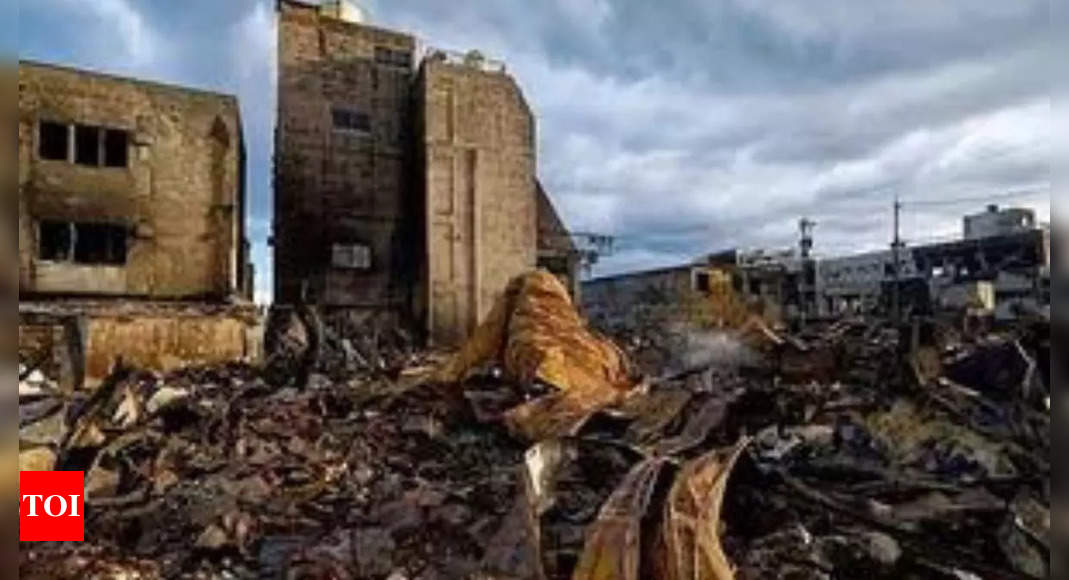
The earthquake that hit southern Japan on Thursday was not a big deal for the country despite its magnitude 7.1 strength as the quake caused minimal damage, however, the earthquake was promptly followed by a major warning from Japan’s meteorological agency, stating that there was a heightened risk of a first-ever “mega earthquake”.
In response to this alarming announcement, Japan’s Prime Minister Fumio Kishida has decided to forgo his scheduled trip to a summit in Central Asia, opting instead to remain in the country for the next week to “ensure our preparations and communications are in order,” BBC reported.
What is the “big one“
Earthquakes with a magnitude greater than 8 are classified as megaquakes. Many Japanese citizens found themselves contemplating the dreaded “big one” – a catastrophic earthquake that occurs once every hundred years, which they had been warned about.
Worst case predictions estimate a death toll surpassing 300,000, with a towering tsunami potentially reaching heights of 30m (100ft) striking along the East Asian nation’s Pacific coast.
What concerns are Japanese authorities currently facing
Japan that is situated on the Ring of Fire, is no stranger to seismic activity, experiencing approximately 1,500 earthquakes annually, while most of these tremors cause minimal damage, there have been devastating exceptions, such as the magnitude 9.0 quake that struck in 2011, triggering a tsunami that claimed over 18,000 lives along the north-east coast.
In 1707, a rupture spanning the entire 600km length of the Nankai Trough triggered Japan’s second-largest recorded earthquake, followed by the eruption of Mount Fuji. These massive “megathrust” earthquakes typically occur every century or so, often in pairs, with the most recent ones striking in 1944 and 1946.
According to experts, there is a 70% to 80% probability of a magnitude 8 or 9 earthquake occurring somewhere along the trough within the next three decades.
According to BBC, Geologists Kyle Bradley and Judith A Hubbard, in their Earthquake Insights newsletter on Thursday, referred to this long-anticipated event as “the original definition of the ‘Big One’”. “The history of great earthquakes at Nankai is convincingly scary” so as to be concerning, the pair acknowledged.
What is the Nankai Trough
The Nankai Trough, situated off the southwest Pacific coast of Japan, is a significant geological feature that extends for roughly 900 km (600 miles). This trough is formed by the subduction of the Philippine Sea Plate beneath the Eurasian Plate.
The convergence of these two tectonic plates along the Nankai Trough results in the accumulation of immense tectonic strains over time. These built-up strains have the potential to trigger a devastating megaquake approximately once every 100 to 150 years, Reuters reported.
Can earthquakes really be predicted
Robert Geller, a retired seismology professor from the University of Tokyo, dismisses the notion that earthquakes can be accurately predicted. In a statement to the BBC, he said, “The issuance of the warning yesterday has almost nothing to do with science.”
He argued that earthquakes are known to be a “clustered phenomenon”, it is “not possible to tell in advance whether a quake is a foreshock or an aftershock” he added.
The Japan Meteorological Agency (JMA) implemented a warning system following the events of 2011, aiming to avert future catastrophes of similar magnitude, on Thursday, the agency utilized this system for the first time.
However, while the warning advised citizens to remain prepared, it did not explicitly instruct anyone to evacuate. In fact, the JMA sought to downplay the possibility of an imminent major risk. “The likelihood of a new major earthquake is higher than normal, but this is not an indication that a major earthquake will definitely occur,” the JMA said.
Why was alert issued if earthquakes can’t be predicted
The system provides the option to issue either a warning or a lower-level alert. An alert was sent out on Thursday urging individuals to be ready for potential evacuation.
Based on anecdotal evidence, the system appears to have been effective. Despite the country’s familiarity with receiving alerts on their phones, the “Nankai Trough” effect and the looming threat of the “Big One” caused people to pause and pay attention.
Despite the terrifying nature of these scenarios, Masayo Oshio was left with confusion. She told BBC: “I am baffled with the advisory and don’t know what to make of it. We know we cannot predict earthquakes and we have been told the big one is coming one day for so long, so I kept asking myself: is this it? But it does not seem real to me.”
“I feel that the government is overplaying it,” she added.
In response to the 7.1 magnitude earthquake that struck near Nichinan, Miyazaki Prefecture on Thursday, officials are assessing the state of previously opened evacuation shelters. According to Kyodo news agency, by Friday morning, 10 municipalities in western Japan’s Kochi Prefecture had established at least 75 evacuation shelters.
Jera Co., a joint venture between Tokyo Electric Power Company Holdings Inc. and Chubu Electric Power Co., said it was on emergency alert, reaffirming communication routes with fuel carriers and evacuation protocols for piers. In several towns authorities are encouraging elderly residents and others to voluntarily relocate to safer areas.
In response to this alarming announcement, Japan’s Prime Minister Fumio Kishida has decided to forgo his scheduled trip to a summit in Central Asia, opting instead to remain in the country for the next week to “ensure our preparations and communications are in order,” BBC reported.
What is the “big one“
Earthquakes with a magnitude greater than 8 are classified as megaquakes. Many Japanese citizens found themselves contemplating the dreaded “big one” – a catastrophic earthquake that occurs once every hundred years, which they had been warned about.
Worst case predictions estimate a death toll surpassing 300,000, with a towering tsunami potentially reaching heights of 30m (100ft) striking along the East Asian nation’s Pacific coast.
What concerns are Japanese authorities currently facing
Japan that is situated on the Ring of Fire, is no stranger to seismic activity, experiencing approximately 1,500 earthquakes annually, while most of these tremors cause minimal damage, there have been devastating exceptions, such as the magnitude 9.0 quake that struck in 2011, triggering a tsunami that claimed over 18,000 lives along the north-east coast.
In 1707, a rupture spanning the entire 600km length of the Nankai Trough triggered Japan’s second-largest recorded earthquake, followed by the eruption of Mount Fuji. These massive “megathrust” earthquakes typically occur every century or so, often in pairs, with the most recent ones striking in 1944 and 1946.
According to experts, there is a 70% to 80% probability of a magnitude 8 or 9 earthquake occurring somewhere along the trough within the next three decades.
According to BBC, Geologists Kyle Bradley and Judith A Hubbard, in their Earthquake Insights newsletter on Thursday, referred to this long-anticipated event as “the original definition of the ‘Big One’”. “The history of great earthquakes at Nankai is convincingly scary” so as to be concerning, the pair acknowledged.
What is the Nankai Trough
The Nankai Trough, situated off the southwest Pacific coast of Japan, is a significant geological feature that extends for roughly 900 km (600 miles). This trough is formed by the subduction of the Philippine Sea Plate beneath the Eurasian Plate.
The convergence of these two tectonic plates along the Nankai Trough results in the accumulation of immense tectonic strains over time. These built-up strains have the potential to trigger a devastating megaquake approximately once every 100 to 150 years, Reuters reported.
Can earthquakes really be predicted
Robert Geller, a retired seismology professor from the University of Tokyo, dismisses the notion that earthquakes can be accurately predicted. In a statement to the BBC, he said, “The issuance of the warning yesterday has almost nothing to do with science.”
He argued that earthquakes are known to be a “clustered phenomenon”, it is “not possible to tell in advance whether a quake is a foreshock or an aftershock” he added.
The Japan Meteorological Agency (JMA) implemented a warning system following the events of 2011, aiming to avert future catastrophes of similar magnitude, on Thursday, the agency utilized this system for the first time.
However, while the warning advised citizens to remain prepared, it did not explicitly instruct anyone to evacuate. In fact, the JMA sought to downplay the possibility of an imminent major risk. “The likelihood of a new major earthquake is higher than normal, but this is not an indication that a major earthquake will definitely occur,” the JMA said.
Why was alert issued if earthquakes can’t be predicted
The system provides the option to issue either a warning or a lower-level alert. An alert was sent out on Thursday urging individuals to be ready for potential evacuation.
Based on anecdotal evidence, the system appears to have been effective. Despite the country’s familiarity with receiving alerts on their phones, the “Nankai Trough” effect and the looming threat of the “Big One” caused people to pause and pay attention.
Despite the terrifying nature of these scenarios, Masayo Oshio was left with confusion. She told BBC: “I am baffled with the advisory and don’t know what to make of it. We know we cannot predict earthquakes and we have been told the big one is coming one day for so long, so I kept asking myself: is this it? But it does not seem real to me.”
“I feel that the government is overplaying it,” she added.
In response to the 7.1 magnitude earthquake that struck near Nichinan, Miyazaki Prefecture on Thursday, officials are assessing the state of previously opened evacuation shelters. According to Kyodo news agency, by Friday morning, 10 municipalities in western Japan’s Kochi Prefecture had established at least 75 evacuation shelters.
Jera Co., a joint venture between Tokyo Electric Power Company Holdings Inc. and Chubu Electric Power Co., said it was on emergency alert, reaffirming communication routes with fuel carriers and evacuation protocols for piers. In several towns authorities are encouraging elderly residents and others to voluntarily relocate to safer areas.









